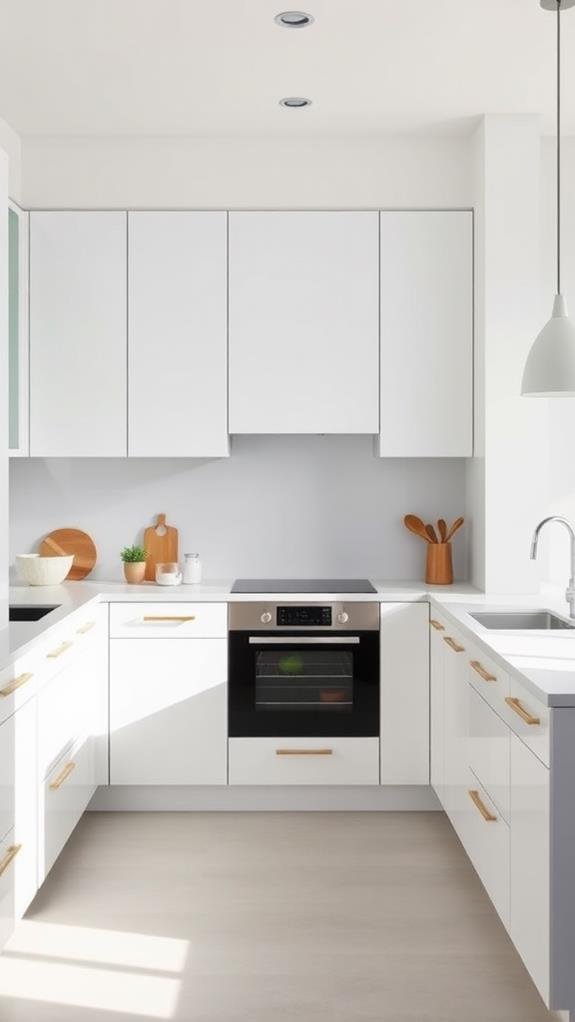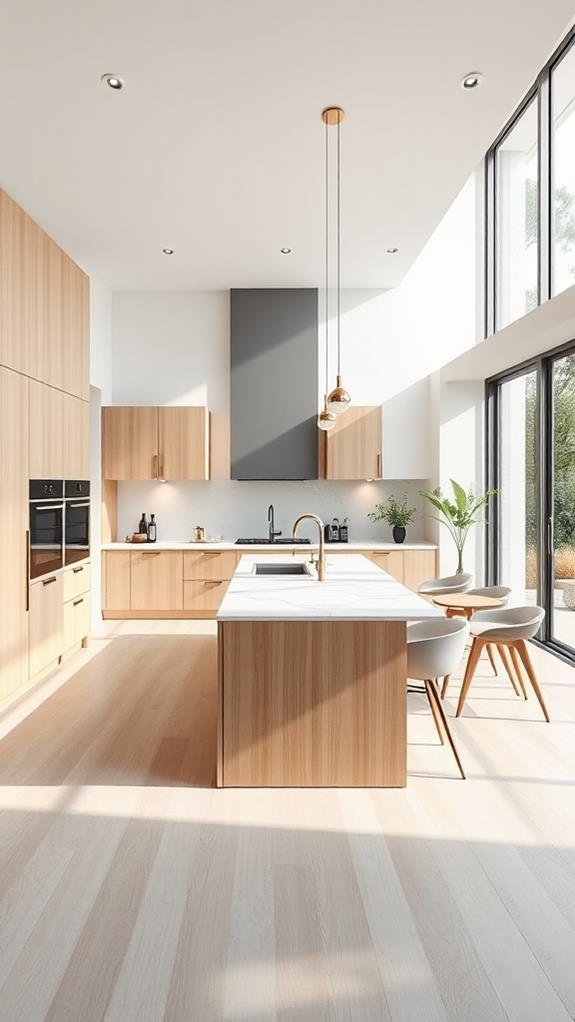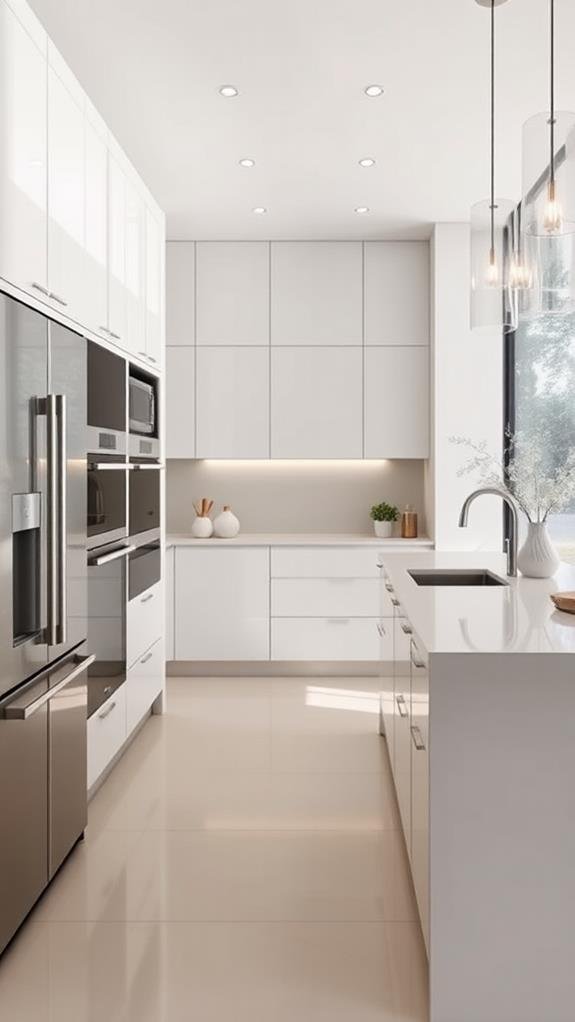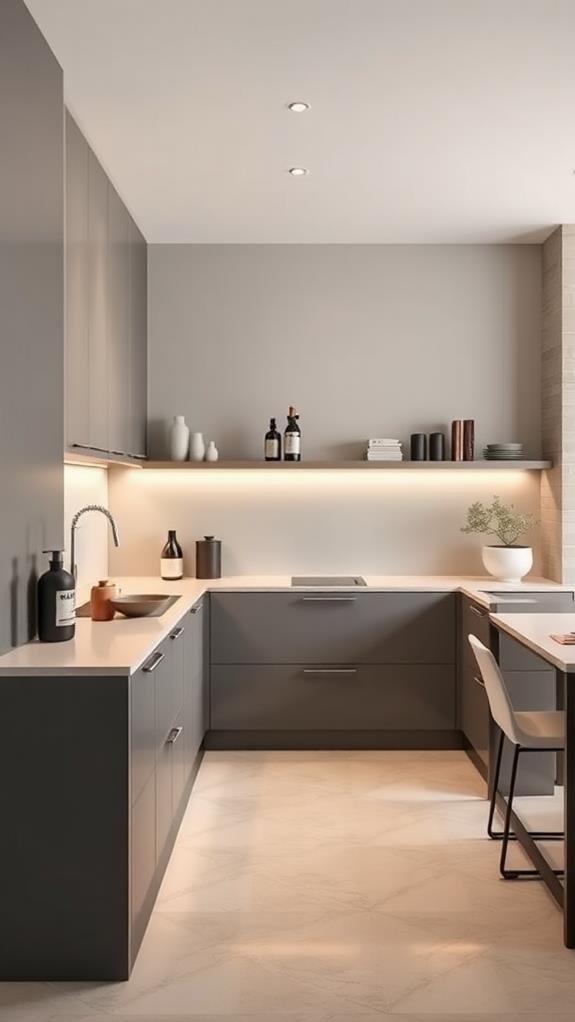Designing a Modern Minimalist Kitchen – A Step-by-Step Guide
Designing a modern minimalist kitchen starts with embracing simplicity and functionality. First, choose a neutral color palette, like whites or soft pastels, to foster calmness. Then, select durable materials such as quartz for countertops and stainless steel for fixtures. An open layout is essential—consider removing walls to connect with living areas, and add seating like an island for social interaction. Optimize storage using high cabinets or drawer dividers to minimize clutter. Finally, incorporate plants for a fresh touch and guarantee natural light fills the space. Stick with these steps, and you’ll create a beautiful, serene kitchen you’ll love.
Key Takeaways
- Embrace simplicity by selecting a neutral color palette and prioritizing clean lines to create a calm environment in your kitchen.
- Choose durable, functional materials like quartz countertops and porcelain flooring to maintain practicality and elegance.
- Design an open layout that connects the kitchen with living spaces, incorporating seating solutions for workspace and social interaction.
- Optimize storage with ceiling-height cabinets, drawer dividers, and magnetic strips to keep surfaces clutter-free and organized.
- Incorporate natural light by using large windows and light colors, along with greenery for a fresh and inviting atmosphere.
Understanding Minimalist Design

Minimalist design strips away the unnecessary, focusing instead on functionality and simplicity.
In a minimalist kitchen, you prioritize clean lines, open spaces, and a curated selection of essential items. You’ll want to choose colors that promote calm, such as whites, grays, or soft pastels.
Every piece in your kitchen should have a purpose, so think carefully about each item you add. Cabinets and appliances often feature a sleek, uncluttered look, making the space feel larger and more inviting.
Light plays an essential role, too; natural light creates warmth and openness.
Key Principles of Minimalism

Adopting minimalist design in your kitchen means understanding its core principles.
First, simplicity is key. You’ll want to focus on clean lines and uncluttered spaces, which help create a calming environment.
Next, functionality plays an essential role. Design your kitchen with practical layouts and storage solutions, so everything has its place.
Also, choose quality over quantity. Select a few well-made appliances and pieces instead of overwhelming yourself with many items.
Another principle is coherence; make certain all elements collaborate to create a harmonious look.
Finally, welcome negative space. This means leaving areas free of decor to improve the minimalist feel.
Choosing a Color Palette

A well-chosen color palette can transform your kitchen into a serene oasis.
Start by selecting a few key colors that reflect your style. Neutrals like whites, grays, and beiges create a calm foundation, while adding soft pastels or muted tones can bring a gentle pop of color.
Consider how colors will work together; you want a cohesive look. If you love bold colors, use them sparingly as accents, so they don’t overpower the space.
Remember to think about natural light, as it affects how colors appear throughout the day.
Take your time with this step; testing paint samples in your kitchen can help you envision the final result. The right palette will make your kitchen inviting and peaceful.
Selecting Functional Materials

When designing a modern kitchen, it’s essential to choose materials that are both functional and aesthetically pleasing.
Start with countertops; options like quartz or granite are durable and easy to clean, making them ideal for busy kitchens.
Next, consider cabinetry materials; MDF or plywood with a sleek finish provides strength without sacrificing style.
For flooring, look for materials like porcelain tile or engineered wood, which can withstand spills and heavy foot traffic.
Don’t forget about backsplashes; glass tiles aren’t only trendy but also easy to wipe down.
Finally, remember to select fixtures like faucets and handles made from stainless steel, as they’re both practical and elegant.
Designing an Open Layout

Creating an open layout in your kitchen boosts both functionality and social interaction.
By removing walls or barriers, you can connect your kitchen with the dining area or living room, making it easier to entertain guests while cooking.
Consider using an island or a breakfast bar to improve the open feel; these features not only provide additional seating but also serve as a workspace.
Use large windows or sliding doors to bring in natural light, which makes the space feel even more inviting.
Choose a cohesive color palette and minimal furniture to maintain that clean, modern look.
With an open layout, you’ll make cooking a communal experience, where everyone feels welcome and included.
Enjoy your new kitchen!
Optimizing Storage Solutions

Maximizing storage solutions in your modern minimalist kitchen is essential for maintaining a clutter-free environment.
Start by using cabinets that reach the ceiling. This not only gives you extra space but also keeps things hidden away. Use drawer dividers to organize utensils and keep everything easy to find.
Open shelving can display your favorite dishes while keeping them accessible—just be mindful of not overcrowding.
Consider magnetic strips for knives and spices; it saves counter space and looks sleek.
Don’t forget about hidden storage options, like pull-out cabinets or built-in benches.
Finally, always evaluate what you truly need; reducing items allows you to optimize your space effectively.
With these strategies, your kitchen will feel spacious and organized.
Emphasizing Natural Light

Emphasizing natural light in your modern minimalist kitchen transforms the space, making it feel airy and inviting.
To let in as much light as possible, choose large windows or glass doors that open to your outdoor area. If privacy is a concern, consider sheer curtains that allow sunlight while maintaining a cozy atmosphere.
Light colors on your walls and cabinets can reflect sunlight, enhancing the brightness throughout the room. You can also incorporate mirrors or shiny surfaces, which help to bounce light around.
Arrange your furniture and decor to avoid blocking windows, ensuring the light flows freely. By maximizing natural light, you create a warm, welcoming kitchen where you’ll enjoy spending time cooking and gathering with family and friends.
Integrating Modern Appliances

Natural light not only brightens your kitchen but also sets the perfect stage for showcasing modern appliances. When integrating these appliances, choose sleek, energy-efficient models that fit your minimalist aesthetic.
Think about built-in ovens, induction cooktops, and refrigerators with clean lines. These appliances not only tidy up your space but also improve its overall look.
You’ll want to examine their placement carefully, ensuring they’re easily accessible while maintaining a clean visual flow. Hidden appliances, like dishwashers behind cabinet doors, can help keep the focus on your kitchen’s design.
Choosing Minimalist Fixtures

When selecting fixtures for your minimalist kitchen, consider both form and function to create a cohesive design.
Start by choosing sleek, simple designs that blend seamlessly with your overall aesthetic. Stainless steel sink faucets or brushed nickel options are excellent choices, as they’re both stylish and durable.
Next, think about lighting: pendant lights with clean lines can improve your space and provide needed illumination. Under-cabinet lighting is another smart addition, creating a warm atmosphere without overwhelming your kitchen’s minimal look.
Don’t forget about cabinet hardware; opt for flat, unobtrusive pulls to maintain uniformity.
Curating a Simple Aesthetic

Creating a minimalist kitchen goes beyond just choosing the right fixtures; it’s about curating a simple aesthetic that feels serene and intentional.
Start by selecting a color palette with soft, neutral tones. Whites, grays, and light beiges help create a calm environment. Choose a few statement pieces that reflect your style, like an elegant bowl or a sleek cutting board, but keep the clutter at bay.
Remember, less is more! Organize your space with clever storage solutions, so everything has its place, making it easy to maintain order. You’ll want to avoid overcrowding the countertops, letting key items shine without distractions.
Utilize negative space to foster an uncluttered atmosphere, promoting a peaceful cooking experience that invites creativity.
Incorporating Greenery

Adding greenery to your minimalist kitchen not only improves aesthetics but also brings life to the space. Consider easy-to-care-for plants like succulents or herbs, which fit perfectly on windowsills or countertops.
Herbs such as basil and mint can enrich your cooking while adding fresh scents to the room. Small potted plants can create a stylish focal point, drawing the eye and breaking up the clean lines of your kitchen design.
Use simple, modern planters that complement your kitchen’s color palette. Don’t forget to arrange your greenery thoughtfully; clusters of plants can create a cozy vibe.
With just a few additions, you’ll transform your kitchen into a vibrant, inviting area that feels warm and alive, all while maintaining that sleek, minimalist look.
Creating a Cohesive Look

A minimalist kitchen thrives on simplicity and cohesion, tying together elements to create a harmonious space. To achieve this, focus on a limited color palette, such as whites, grays, or muted tones.
When selecting materials, stick with natural choices like wood, stone, or metal, ensuring they blend seamlessly. Your appliances, fixtures, and cabinetry should complement each other through consistent styles and finishes. For example, if you choose sleek stainless steel appliances, pair them with modern, minimal hardware.
Pay attention to lighting, too; a unified look can be improved with matching fixtures.
Personalizing Your Space

Personalizing your minimalist kitchen can transform it into a unique reflection of your style and taste. Start by adding colorful accessories, like bold dishware or interesting kitchen gadgets that catch the eye.
You might also consider incorporating artwork or personal photos to create warmth and character. Choose a few decorative items that evoke happy memories, but keep it simple to maintain that minimalist feel.
Another way to personalize is through plants; they not only add a pop of color but also breathe life into the space.
Finally, select a signature scent, like fresh herbs or citrus, to make your kitchen inviting.
Maintaining a Clutter-Free Environment

To maintain a clutter-free environment in your minimalist kitchen, regularly review what you truly need.
Start by examining your kitchen tools and gadgets; if you haven’t used something in the past year, consider donating it. Keep counters clear by storing appliances in cabinets when they’re not in use.
Designate a specific spot for everything, so items don’t end up scattered around. Make it a habit to wipe down surfaces daily, removing any unnecessary items that accumulate.
When shopping, stick to a list to avoid impulse buys that could clutter your space. Finally, involve your family in maintaining this clean atmosphere; together, it’ll be easier to create a peaceful, functional kitchen that you’ll love spending time in.
Conclusion
Designing a modern minimalist kitchen isn’t just about simplicity; it’s about creating a space that feels open, functional, and inviting. By following the steps outlined, like choosing a calming color palette and keeping the layout open, you can transform your kitchen into a peaceful hub. Remember, personal touches make the space yours, so don’t hesitate to add your favorite elements. With a focus on organization and practicality, your minimalist kitchen will be both stylish and enjoyable to use every day.
